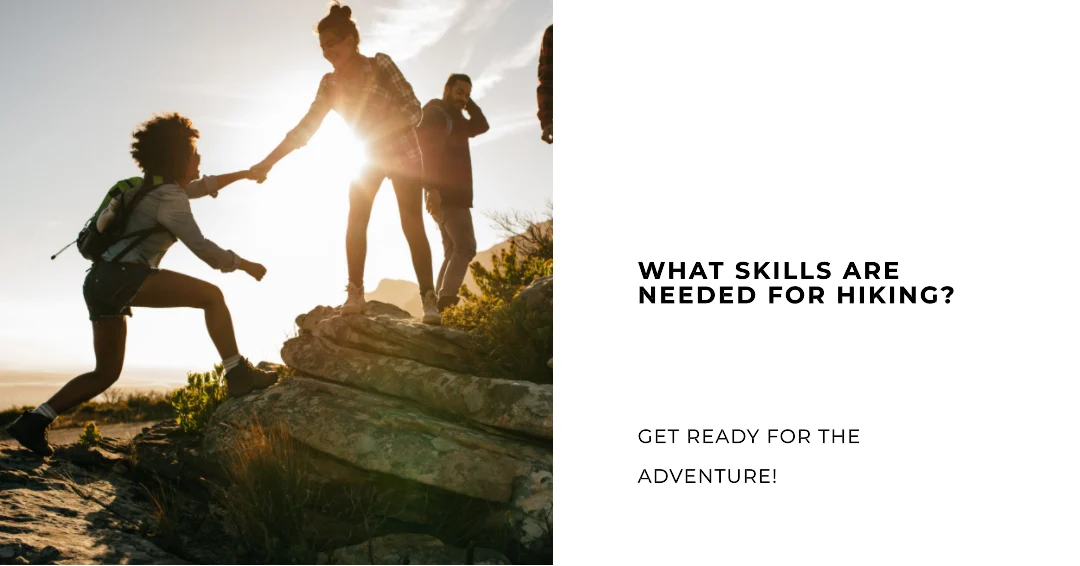Table of Contents
Some links on posts are affiliate links and will earn us a commission from qualifying purchases
Have you ever wanted to experience the thrill of pushing yourself physically while exploring some of nature’s most awe-inspiring landscapes? Hiking is an exciting activity that can open up a world of adventure and exploration. But before embarking on your first hike, there are certain skills that you should know and understand to ensure the greatest possible fun and safety. In this blog post, we’ll discuss the various skills needed for hiking, ranging from basic map reading to advanced route-finding techniques.
Understanding the basics of hiking safety and proper trail etiquette
Hiking in the great outdoors can be an incredibly rewarding and invigorating experience, allowing you to fully immerse yourself in the beauty of nature and the wonders of the world around you. However, as with any outdoor activity, it’s important to remember that safety always comes first.
Before hitting the trail, it’s essential to be fully prepared and have all the right gear to keep you safe and comfortable throughout your journey. This includes suitable shoes or boots that are comfortable and provide good traction, extra water and snacks to keep you hydrated and nourished, a map or GPS device to help keep you on track and avoid getting lost, a well-stocked first-aid kit in case of any accidents or injuries along the way, and, of course, sun protection to keep your skin safe from harmful UV rays.
But it’s not just about having the right gear and supplies – proper trail etiquette is equally important when it comes to ensuring that everyone can enjoy the great outdoors safely and responsibly. By staying on designated trails, yielding to uphill hikers, and properly disposing of any waste you generate along the way, you can help minimize your impact on the environment and other hikers, while maintaining a positive outdoor experience for all.
So, whether you’re a seasoned hiker or just starting out, understanding the basics of hiking safety and trail etiquette is essential for anyone looking to confidently venture out into nature and enjoy all of its unparalleled beauty.
Knowing how to read a map and interpret terrain features such as contour lines
In today’s age of GPS and smartphone navigation, it’s easy to forget the value of knowing how to read a map. But outdoor enthusiasts know that paper maps are more reliable than electronic devices when outside the concrete jungle. Having a basic knowledge of reading maps can distinguish a successful expedition from a nightmare of getting lost in the wilderness.
The first rule of map reading is understanding how to interpret terrain features. Terrain features such as contour lines form the basics of map reading. Contour lines provide a 3D perspective of the land’s shape and its elevations. With this knowledge, hikers can prepare for any obstacles or challenges that may come while mapping their route. Planning a route based on a map’s terrain features is the best way to anticipate nature’s surprises and unlock undiscovered paths.
Thus, when you’re planning on embarking on outdoor activities or exploring unfamiliar terrain, remember the first rule: decipher the map’s terrain features and conquer the terrain. Happy exploring!
Being aware of your physical fitness level and how it affects your ability to hike
Before embarking on a hike, it is crucial to take a few steps to assess your physical fitness and how it could impact your journey. You may need to consider your level of endurance, strength, mobility, and anything else that could affect your ability to tackle different types of terrain and elevation changes.
While some hikes may be lower in intensity and more manageable for beginners, others could be more complex and demanding, calling for greater physical exertion and mental focus. It’s important to be honest with yourself about your fitness level and to select a hike that aligns with it for a safer and more enjoyable experience. Pushing yourself too hard too soon could lead to injuries or burnout, hampering your progress and putting future hikes at risk.
Thankfully, hiking provides a fantastic opportunity to connect with nature and enhance your physical fitness in measurable ways. By gradually building up your abilities and taking on more challenging hikes over time, you are not only improving your performance but also your mental resilience and overall well-being. So don’t be afraid to set realistic goals for yourself and enjoy the journey, one step at a time!
Knowing the types of clothes, equipment, and supplies that are necessary for a successful hike
Hiking is an exhilarating way to enjoy the great outdoors while simultaneously getting some exercise. However, before you embark on this adventure, it’s essential to prepare yourself adequately. To ensure a successful hike, having the right clothing, equipment, and supplies is crucial.
When it comes to clothing, you should consider a variety of factors, such as the weather, duration of the hike, and terrain. It’s important to choose comfortable, moisture-wicking clothing that provides ease of movement. Layering is key for staying comfortable in fluctuating weather conditions; choosing breathable, light-weight layers that can be added or removed as needed is a wise choice.
In terms of footwear, high-quality hiking boots are a must-have. They provide good ankle support, tread for traction, and protection from rough terrain, rocks, and other hazards. Investing in a high-quality pair of hiking boots is a wise investment for both safety and comfort.
Finally, it is important to pack plenty of water, snacks, and a first-aid kit to ensure you’re prepared for any emergency. Dehydration and hunger are common problems faced by hikers, so it’s best to come prepared with enough sustenance for the duration of your trip. Packing a lightweight first-aid kit with essentials such as band-aids, alcohol wipes, and gauze can help you treat an injury on the trail.
By taking the time to pack the right gear and prepare yourself accordingly, you’ll be ready to tackle any trail with the confidence that comes with being well-prepared.
Having the ability to identify poisonous plants and animals in your area and knowing how to avoid them
Exploring the great outdoors is a fantastic way to enjoy some fresh air, sunshine, and exercise. However, while getting close to nature, it’s crucial to understand how to stay safe and avoid potential dangers. One key skill that outdoor enthusiasts should learn is how to identify poisonous plants and animals in their area. From venomous snakes and spiders to dangerous plants like poison ivy, it’s vital to know how to recognize and avoid these potentially life-threatening hazards.
Moreover, while we often think of poisonous plants and animals as being rare or unusual, they, in fact, are more common than we think. Even seemingly benign creatures like caterpillars and ladybugs could cause allergic reactions if mishandled or ingested. The same goes for some mushrooms that could produce fatal effects if consumed by mistake. Therefore, it’s essential to be knowledgeable and take precautions whenever you’re in the great outdoors. This way, you can fully embrace the beauty of nature without compromising your safety or health.
Understanding the importance of maintaining hydration levels while out on a hike
Hiking is a wonderful activity that comes with an array of health benefits, from physical exercise to mental clarity and a deeper connection with nature. But amidst all the joys, it’s essential to remember that hiking can be strenuous and requires proper preparation to mitigate the potential risks.
One crucial aspect to consider is maintaining optimal hydration levels while out on a hike. Dehydration can strike unexpectedly, leading to a host of discomforts such as headaches, fatigue, and dizziness. In some instances, dehydration can lead to more severe consequences, such as heat exhaustion or heat stroke, depending on the climate and hiking location.
So, when preparing for your hike, it’s vital to pack enough water to avoid dehydration and keep your body functioning at its best. However, water is not the only source of hydration to consider since drinking too much of it can lead to frequent bathroom breaks and, worse, hyponatremia, a condition that occurs when sodium levels in the body become dangerously low due to overhydration. Therefore, it’s advisable to carry other types of drinks that can help provide necessary electrolytes and nutrients. Some great options include sports drinks, coconut water, and fruit juices.
Remember, staying hydrated can make all the difference between an enjoyable hike with lasting memories and a regrettable and harmful experience. So, before hitting the trails, plan ahead, and make sure to equip yourself with everything you need to stay hydrated, comfortable, and safe.
Conclusion – skills required for hiking
Now that you have a better understanding of the basics of hiking safety and trail etiquette, you should be more confident when planning your next hike in the country. Even if you are not an expert hiker, it is important to remember the basics and to brush up on your knowledge periodically.
Don’t forget that going with a group or experienced hiker is one of the best ways to stay safe while out in nature. Additionally, always prepare for any eventuality by bringing enough food, water, and supplies to last a few extra days as well as first aid and navigational equipment.
With the right knowledge and preparation, your next hike can be an enjoyable experience filled with breathtaking vistas, unspoiled nature, and treasured memories.
Recent Posts
Hiking is one of the best ways to get outdoors, enjoy nature, and have fun. It’s a great activity for all ages, can be done anywhere with a variety of terrain options, and has health benefits like...
What is fun about hiking? Take the first step to loving a new hobby
You’ve probably heard your friends talking about their amazing hiking experiences, and you might be wondering why it’s such a big deal. We all understand the appeal of getting away from our...


